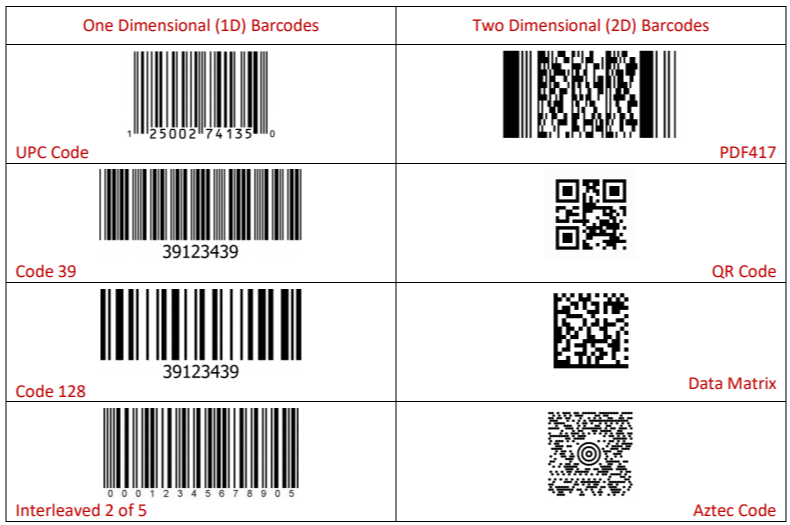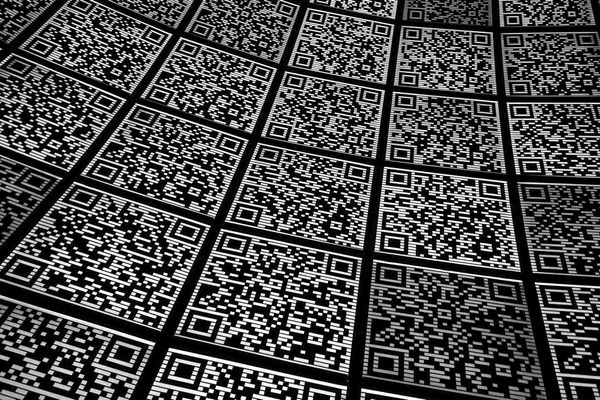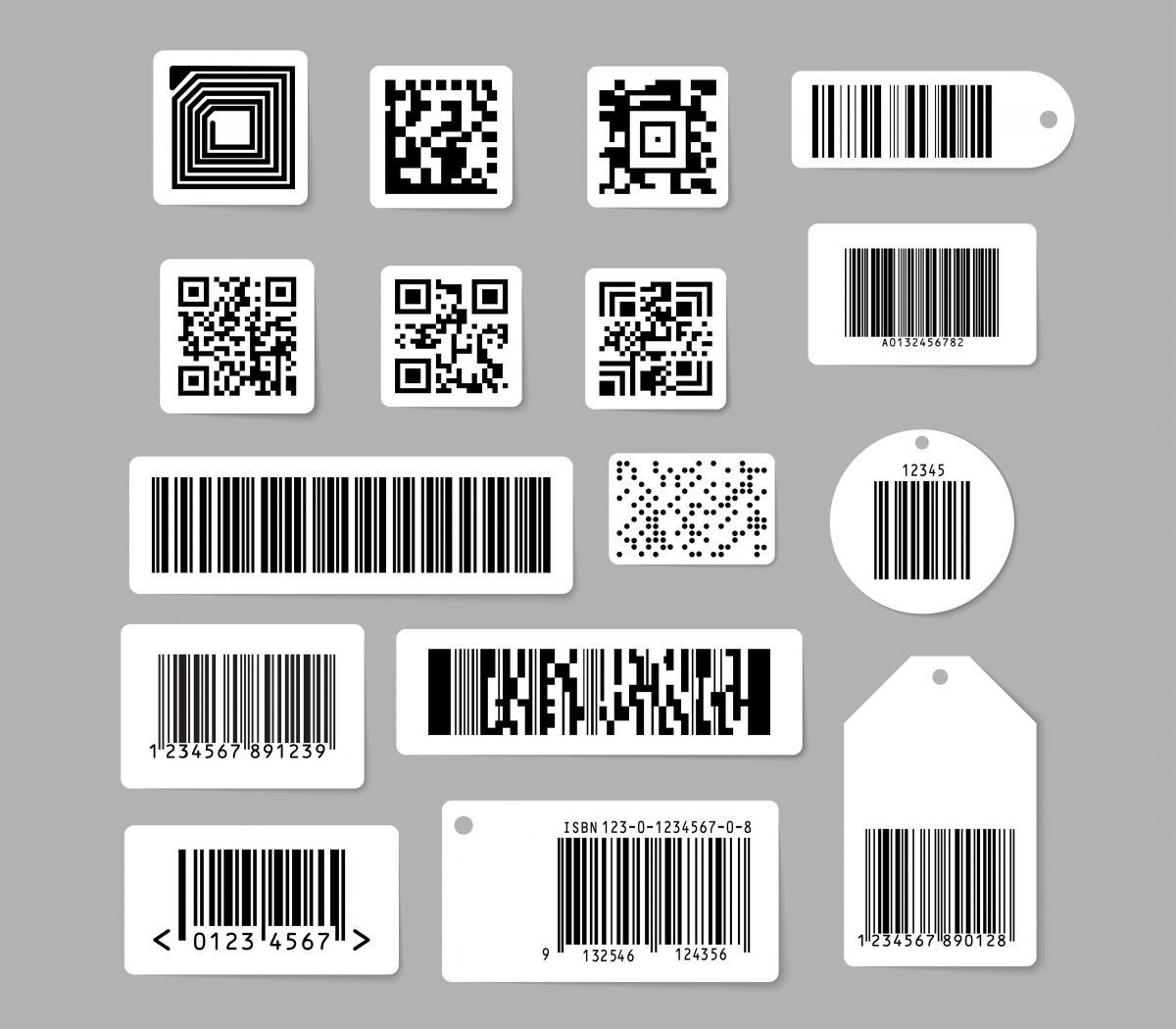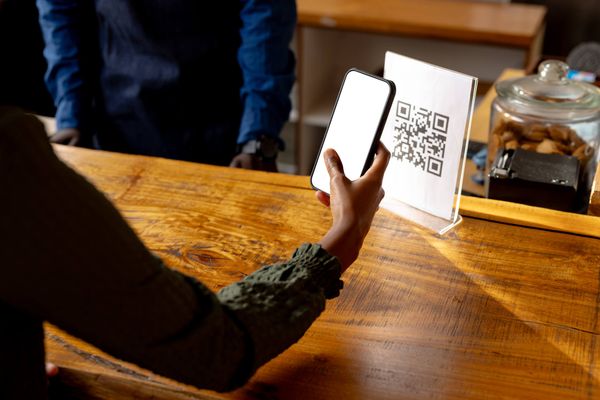In this concise guide, we'll unravel the key differences between QR codes and barcodes, which are essential for any business.
We'll explore their unique designs, from QR codes' distinctive squares to barcodes' varied lines. We'll also touch upon their types and advantages, to compare QR codes vs. barcodes properly. By the end, you'll be equipped to make an informed choice. Let's begin!
What Is A Barcode?
The QR code vs. barcode journey begins with properly understanding barcodes.
A barcode is a method of representing data in a visual, machine-readable form. It consists of varying widths and spacings of parallel lines — and is usually seen on products in retail stores, on tickets, and even in your daily mail!
The origin of the barcode can be traced back to 1952 when inventors Joseph Woodland and Bernard Silver patented the technology.
However, it wasn't until 1974 that a barcode was first used commercially on a pack of Wrigley's Juicy Fruit chewing gum, marking the beginning of a revolution in inventory management and business efficiency.
Types of 1D Barcodes
As we proceed further into our 'QR code vs. barcode' analysis, it's essential to understand that the world of barcodes is divided into two main types: 1D (one-dimensional) and 2D (two-dimensional).
For this section, though, we'll solely focus on 1D barcodes. These linear barcodes only carry information in one direction (horizontally) and are read left to right by a scanner.
1D barcodes are further distinguished into several types:
- UPC Barcodes: Universal Product Codes are used widely for retail packaging in the United States.
- EAN Barcodes: European Article Numbering is the international standard barcode for retail food labels.
- Code 128: This is a high-density linear barcode symbol used for alphanumeric or numeric-only data.
- ISBN: International Standard Book Number is used worldwide for identification.
- Interleaved 2 of 5 (ITF): ITF barcodes are commonly used in warehousing and industrial applications.
Each type has unique attributes and applications, making them suitable for different needs.
Applications for 1D Barcodes
1D barcodes are convenient and easy to print using common printers, making them popular for various applications. Here are some of their popular uses:
- Retail Shopping: This is the most recognized use of barcodes. Watch as any item bought at a store gets quickly scanned at the checkout.
- Library Systems: Barcodes help to track books and library holders, making borrowed book management a breeze.
- Ticketing Systems: Event, plane, or movie tickets, you name it! Barcodes ease the ticket validation process.
- Asset Tracking: Businesses use barcodes on office supplies and equipment. This helps them maintain an accurate inventory.
- Hospitality and Tourism: Barcodes are used in hotels to identify luggage and in tourism to track visitors' movements.
Advantages of 1D Barcodes
Why have 1D barcodes been used so widely? The reasons are not farfetched! They offer several fantastic benefits:
- Operational Efficiency: Barcodes fast-track many processes like invoicing, delivery, and record maintenance, boosting operational efficiency.
- Reduction of Errors: Manual data entry is prone to errors. Barcodes substantially reduce human errors.
- Cheap to Implement: 1D barcodes do not require high-end printing technology, making them cost-effective for businesses.
- Time-Saving: Barcodes save time by allowing rapid data entry and retrieval.
What Is A QR Code?
Having explored the fundamentals of 1D barcodes, it's high time we switch gears and meet another significant player in our QR code vs. barcode comparison - the QR code.
QR stands for 'quick response,' a system initially designed to track vehicle components at high speed during manufacturing.
Since then, QR codes have swept the digital landscape, and finding a marketing strategy they're not a cardinal part of is tough.
So, let's take off on this essential journey toward understanding QR codes, their applications, and their inherent advantages.
QR codes, invented by Denso Wave in 1994, surpass traditional barcodes with their advanced capabilities.
These 2D codes, easily scanned by smartphones, store data both horizontally and vertically using a pattern of square dots on a white grid. Unlike barcodes, QR codes can hold over 7,000 characters, including alphanumeric, binary, and even Kanji data, offering vast storage possibilities.
Applications for QR Codes
With the rise in smartphone use worldwide, the utilization of QR codes has exploded across multiple sectors. Dive into the following applications of QR codes and see how they permeate our daily lives:
QR codes are transforming various sectors with their versatile and user-friendly technology:
Marketing and Advertising:
- QR codes link offline content to online resources.
- Used in flyers, brochures, billboards, and packaging.
- Ideal for detailed product info, offers, and social media engagement.
Payment Systems:
- Dominant in Asia, QR codes simplify transactions.
- Businesses generate QR-linked payment accounts for easy customer scanning.
Product Tracking:
- Vital in manufacturing and retail for real-time updates.
- Enhances inventory management by linking to databases.
Education:
- Diversifies learning methods and resources.
- Useful for digital resources, library tracking, interactive games, and quizzes.
Advantages of QR Codes
QR codes bring a whole new level of appeal to marketing strategies and operational efficiency. Let's stitch the rewards together, shall we?
- Large Data Capacity: A QR code can store much more data than a 1D barcode, including texts, URLs, phone numbers, emails, and even GPS coordinates.
- Fast, Easy Scanning: With a smartphone, scanning and reading a QR code takes mere seconds, offering convenience to the user.
- Versatile Application: QR codes are universal. They can be used in various industries, and their functions transcend beyond item tracking or inventory management, extending into adverts, education, and much more.
- Corrections and Readability: QR codes possess error correction capability, which means they can still be read even with about 30% damage. The square dots that make up a QR code can also be read from any direction - a feature known as omnidirectional scanning.
You might still be wrapping your head around the impressive features attached to a QR code (we don't blame you).
Understanding the Differences: QR Code vs. Barcode
Now that we've gotten acquainted with barcodes and QR codes, it's time to unravel the nitty-gritty of their differences.
We're plunging headfirst into one of the most critical sections - contrasting QR code and barcode.
Appearance and Structure
One of the most distinctive differences between a barcode and a QR code lies in their physical structure and appearance, and understanding these dissimilarities is critical in our QR code vs. barcode comparison!
Barcodes, generally, are one-dimensional, consisting of a series of various widths and spacing of parallel lines that display data from left to right. They are a series of vertical lines that vary in width and spacing and can only support about 20-25 characters of data.
QR codes, on the other hand, catapult us into two dimensions! These codes can hold much more data as they are captured as square-shaped patterns arranged within a square grid.
Their appearance might remind you of an abstract, pixellated work of art, with black squares arranged on a white grid, able to be scanned in any direction.
Information Retention Capacity
Storage capacity is a pivotal factor in choosing between QR codes and barcodes:
1D Barcodes:
- Capacity: Holds about 20-25 characters.
- Ideal For: Tracking inventory in retail, libraries.
- Sufficiency: Adequate for basic data storage needs.
QR Codes:
- Capacity King: Stores up to 7,000 alphanumeric characters.
- Data Types: Handles numeric, alphanumeric, binary, and Kanji.
- Versatility: Perfect for linking real-world items to digital information.
- Use Cases: Extensively used in marketing and payment systems.
Remember, the right choice depends on your specific data storage requirements.
Adaptation And Error Correction
In our QR code vs. barcode comparison, adaptation and error correction capabilities are key:
Barcodes:
- Adaptation Leader: Established in product tracking, ticketing, library systems.
- Simplicity & Dependability: Easy to print and read.
- Error Resilience: Modern scanners improve accuracy, reducing misreads.
QR Codes:
- Error Correction Superiority: Can restore data with up to 30% damage.
- Omnidirectional Scanning: Decodable from any angle.
- Versatile Usage: Effective even in challenging conditions.
Each technology's strengths cater to different needs, with QR codes excelling in robust error correction and barcodes in established, straightforward applications.
A Comparative Study of Readability
Undoubtedly, readability is a critical factor in the QR code vs. barcode discussion. Let's dive into it headfirst:
- Barcode Readability: A barcode's readability is generally reliable if the scanner aligns with the barcode's direction. This makes barcode labels perfect for quick, routine scan-ins but might introduce a hitch if not placed correctly.
- QR Code Readability: QR codes truly shine here! Their omnidirectional scanning feature lets them be read from any angle. In addition, their robust error correction capabilities let them retain readability even when they're somewhat dirty or damaged.
QR Codes vs. Barcodes: Which is Better for Manufacturers?
You're getting the hang of this 'QR code vs. barcode' discussion, and we feel the momentum growing with every line we uncover. We're heading into a vital scenario that troubles many - manufacturing.
Here's where we ask: in this industry, who takes the crown, QR codes, or barcodes?
Together, let's explore the potential usability of both technologies in the manufacturing realm.
Usability of Barcodes in Manufacturing
Exploring the role of barcodes in manufacturing reveals why they've been a longstanding favorite:
- Ideal for Inventory Management: Perfect for tracking numerous manufacturing components.
- Cost-Effective Design: Simple and inexpensive to produce.
Space Efficiency:
- Slim Profile: Fits into tight spaces where QR codes might not.
- Advantage in Label Printing: Especially where space is limited.
Scanning Efficiency:
- Horizontal Reading: Enables scanning from a distance.
- Useful in Warehousing: Ideal for high shelf storage.
Proven Resilience: Long-established adaptability in manufacturing.
While barcodes maintain their traditional stronghold, the emergence of QR codes prompts a reevaluation of their potential in manufacturing contexts.
Potential of QR Codes in Manufacturing
QR codes are rapidly emerging as strong contenders in the manufacturing sector:
Advanced Data Storage:
- Holds extensive information like item details, dates, manufacturer info.
- Surpasses 1D barcode capacity.
Compact and Versatile:
- Fits on small components where barcodes can't.
- Ideal for detailed traceability and quality control.
Time and Cost Efficiency:
- Streamlines processes, reduces errors.
- Enhances customer interaction with products.
Robust Error Correction:
- Functional even when partially damaged.
- Ensures data integrity under adverse conditions.
Smartphone Readability:
- Adds convenience in scenarios where traditional scanners aren't available.
The QR code vs. barcode battle in manufacturing is closely contested, with each offering unique advantages. The key is to find the 'best fit' for your specific manufacturing needs, rather than a one-size-fits-all solution.
So, who's better?
It's a tough call, isn't it? Both barcodes and QR codes offer distinct, substantial benefits for manufacturing. The 'QR code vs. barcode' showdown in manufacturing seems to be quite close, and the choice profoundly depends on the unique factors, needs, and constraints of a given manufacturing environment.
QR codes vs. Barcodes: Which Should You Use for Equipment?
We're steadily moving further into our fantastic QR code vs. barcode journey together. We've ventured through manufacturing and uncovered intriguing facts - now it's time to shift our gaze toward a new frontier - equipment.
Let's not keep you in suspense! Onwards we go to reveal the advantages of QR codes over barcodes for equipment and a deeper probe into whether QR codes are always the better choice.
Advantages of QR codes over Barcodes for Equipment
Equipment, unlike retail products, often needs to retain more data - from maintenance schedules to operation manuals, detailed manufacturing information, and much more. This is a unique challenge, and it's one where QR codes potentially take the lead.
1. Robust Information Storage
The robust information storage capabilities of QR codes, as we've previously established, are a cornerstone of their application.
These codes can store manufacturer details, maintenance schedules, safety instructions, and other essential information, proving exceptionally handy for those managing or operating the equipment.
2. Global Accessibility
Since QR codes can be easily scanned using any modern smartphone, they offer global accessibility to stored information.
No need for specialized equipment or software, which makes QR codes very user-friendly.
3. Real-Time Updates
QR codes can be linked to web databases, providing real-time updates about the status of the equipment, maintenance schedules, and other dynamically changing information.
It's like you're carrying an entire equipment manual on the tip of your fingers.
Now, who wouldn't appreciate such convenience?
4. Error Correction Capabilities
We know by now that QR codes are resilient and can still function even when damaged to some extent - a significant advantage, especially in rough industrial environments where equipment labels can be prone to wear and tear.
5. Compact Sizing
Lastly, due to their compact size, QR codes can be placed in tight spots on equipment pieces where a conventional barcode might not fit.
QR codes, considering these factors, might already seem like the logical choice for equipment management.
How Barcode & QR Codes Affect Equipment Tracking with Mobile Devices
The progression from traditional handheld scanners to mobile devices in equipment tracking has been perceptible in the past years.
Mobile devices equipped with high-resolution cameras and power-packed processors have made scanning barcodes and QR codes possible without demanding any extra hardware.
Pronouncing this as a game-changer wouldn't be an overstatement.
So, welcome to the modern world where your smartphone isn't merely a communication tool; it's your inventory manager, logistics tracker, and personal auditor. Exciting times, right?
Let's explore how barcodes and QR codes are shaping this 'smart' ecosystem:
The Barcode's Influence
Using mobile devices for barcode scanning offers multiple perks. Not having to invest in a dedicated scanner certainly tops the chart! Your equipment tracking woes are sorted with a smartphone and a decent barcode scanner app.
Whether you're running a small business that needs a simple inventory management setup or a larger organization requiring extensive asset tracking, mobile-based barcode scanning can cater to all these needs.
Furthermore, syncing this data to your cloud or server ensures that your backend systems are always up-to-date, providing you with real-time information.
The QR Code's Role
While barcodes have laid the stepping stones to mobile-based equipment tracking, QR codes have sprinted even further in this race.
Thanks to their sizable information storage, QR codes have made linking to digital resources, including databases and websites, easier than ever.
Let's add the ability to scan QR codes without aligning the camera perfectly. Coupled with their error correction capabilities that tolerate some wear and tear, these codes offer extensive usability perks.
Mobile devices can decipher QR codes speedily, offering efficiency, convenience, and digital prowess—all at the swipe of your phone!
QR codes have opened new realms of possibilities, from tracking equipment to accessing service records, operating instructions, warranty details, and more.
Choosing the Right Technology for Your Needs
In our journey through the QR code vs. barcode landscape, we've uncovered their strengths and unique applications. Now, it's time to make an informed decision.
Consider these key points:
Nature of Your Business:
- Barcodes: Ideal for retail due to simplicity.
- QR Codes: Better for tech-focused or consumer-facing businesses for interactive use.
Type and Volume of Data:
- Barcodes: Suited for basic identification.
- QR Codes: Excel in storing complex, large-volume data.
Cost Efficiency:
- Barcodes: More cost-effective initially.
- QR Codes: Offer greater long-term ROI with advanced data and interaction capabilities.
Space Constraints:
- Barcodes: Longer and linear.
- QR Codes: Compact, storing more data in less space.
Understand Your Information Needs:
- Barcodes: For basic product identification/tracking.
- QR Codes: For complex or large data storage.
Analyze Your Working Environment:
- QR Codes: Better for harsh conditions with error correction.
- Barcodes: Efficient in clean, indoor settings.
Evaluate the Affordability:
- Barcodes: Cheaper, easy in-house printing.
- QR Codes: Higher upfront cost, more features.
Balance these considerations with your business strategy, infrastructure, and customer experience. Your choice should cater to current needs while being adaptable for future advancements.
The Bottom Line
Our journey across the vast and varied landscapes of QR code vs. barcode land has been immensely rewarding. Together, we've dug deep, risen high, unraveled truths, defied myths, and, most importantly, learned abundantly.
So who won, you ask? Was the team QR code, or did the barcode hold its ground? We find that the answer is more than just a name.
The victor in the QR code vs. barcode battle is you — the informed, knowledgeable decision-maker. You now hold the power to align these technologies with your operational goals for optimal performance and business efficiency.




















